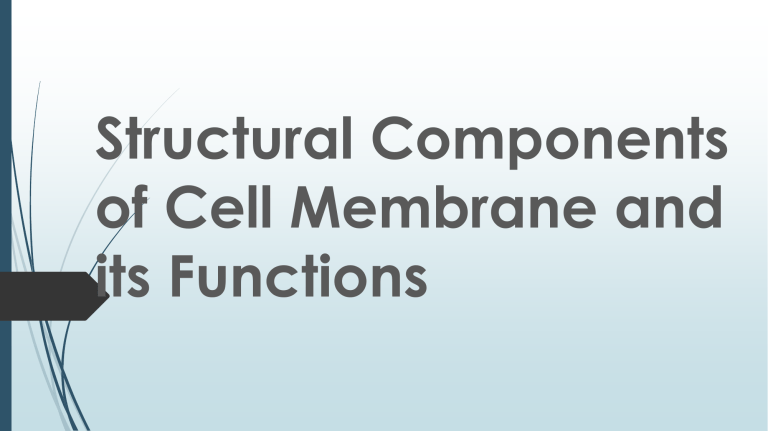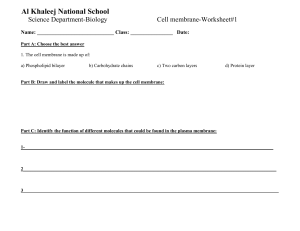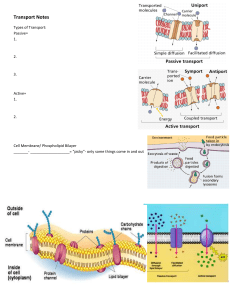
Structural Components of Cell Membrane and its Functions The Cell Membrane Cell Membrane (also known as plasma membrane) a physical and chemical barrier which separates the inside and outside of the cell providing fixed environment inside the cell. It is a bilayer of lipid with embedded proteins and lipids. The plasma membrane mediates cellular processes by regulating the materials that enter and exit the cell Figure 1. The cell membrane The Structural Components of the Cell Membrane The cell membrane is composed of three main components: lipids, proteins, and carbohydrates The ratio of lipids and proteins in the cell membrane is 1:1 or 50% lipids and 50% proteins. Membrane protein in the cell membrane is several times larger than the lipid molecule, but lipid molecules are 50 times more than protein molecules. The ratio is not absolute and varies from membrane to membrane 1. Phospholipid Bilayer The fundamental building block of cell membrane is the phospholipid which is an amphipathic molecule, consisting of both hydrophobic and hydrophilic regions. The hydrophilic or “water loving” (polar) region is the globular head containing phosphate group; the hydrophobic or “water-fearing” (nonpolar) regions are their fatty acid tails. hydrophobic regions of the phospholipids are shielded from the aqueous environment since it is poorly soluble in water and constitute a barrier impenetrable to almost all substances, hydrophilic regions are exposed to high water content region. Proteins are found inserted into this lipid bilayer and are classified into integral proteins and peripheral protein Figure 3. The Amphipathic nature of the phospholipid It is also semi-permeable in nature, where it is impermeable to water-soluble molecule but not to water. Approximately, the phospholipid to phospholipid thickness of the cell membrane is about 5-10nm. 2. Protein Protein, the second major component of the cell membrane is grouped into three distinct classes depending on their relationship to the lipid bilayer a. Integral proteins integrated into the membrane proteins that penetrate the lipid bilayer. They pass entirely through the lipid bilayer and protrude from both the extracellular and cytoplasmic sides of the cell membrane. Figure 4. The Membrane Proteins b. Peripheral proteins membrane proteins that are associated within the surface of the cell membrane and found either on the cytoplasmic or extracellular side. Unlike integral protein, they do not stick into the hydrophobic core of the membrane and they tend to be more loosely attached. Figure 4. The Membrane Proteins c. Other Types of Proteins present in the Cell Membrane Channel proteins allow the movement of some substances, such as the large molecule sugar, into and out of the cell as they can’t travel directly through the cell surface membrane. The channels can be opened or closed to control the substances’ movement. Carrier proteins actively move substances across the cell surface membrane, using energy from ATP. Adenosine triphosphate (ATP) is the source of energy for use and storage at the cellular level. 3. Carbohydrates Carbohydrates are the third major component of the cell membrane. In general, they are found on the outside surface of the cells and are bound either in protein forming glycoproteins or to lipids forming glycolipids. These carbohydrates may consist of 2-60 monosaccharide units and can either be straight or branched. Cell surface receptors are glycoproteins responsible for the binding of an extracellular signalling molecule (hormones and cell surface antigens) and transduction of its messages into one or more intracellular signalling molecules, which changes the cell’s behaviour. Help to interact with other cells. Help to recognise cells: glycoproteins are specific for cells from a particular individual or a particular tissue The Fluid Mosaic Model The fluid mosaic model describes the cell membrane as several molecules (phospholipid, cholesterol and proteins) that are constantly moving. This movement helps the cell membrane maintains its role as a barrier between the inside and outside of the cell environment. The fluidity of a cell membrane depends on the lipid composition of the membrane, the density of integral proteins, and the temperature. The fatty acids and cholesterol play an important role in the fluidity of the cell membrane. Figure 7. The Fluid Mosaic Model Role of Fatty Acids The structure of the fatty acid tails of the phospholipid is important in determining how fluid is the membrane. Saturated fatty acids have no double bonds, so they are relatively straight while unsaturated fatty acids contain one or more double bond, often resulting in a bend or kink. A long chain of saturated fatty acids have greater interactions among themselves making the cell membrane stiffer. While more unsaturated fatty acids in the lipid tails make the membrane becomes less tightly packed resulting to the increase of the cell membrane fluidity. Thus, at cooler temperature the straight tails of saturated fatty acids can pack tightly together, making a dense and fairly rigid cell membrane while unsaturated fatty acid tails cannot pack together as tightly because of the bent structure of the tails making the cell membrane to stay fluid at lower temperature. Role of Cholesterol The presence of cholesterol in the membrane makes it possible for the cell membrane to maintain its fluidity across a wide range of temperatures. It helps to minimize the effects of temperature on fluidity. At low temperature, cholesterol increases the fluidity by keeping the phospholipids from packing tightly together while at high temperature, it reduces fluidity. In this way, cholesterol expands the range of the temperatures at which a membrane maintains a functional healthy fluidity. The number of cholesterol molecules in the membrane can be as high as the number of phospholipids. A high amount of cholesterol in the phospholipid bilayer makes the cell membrane remains fluid. While having a high density of integral proteins makes the cell membrane have less fluid. The Importance of Membrane Fluidity Membrane fluidity provides a perfect compromise between a rigid structure which makes mobility absent and a completely fluid where mechanical support would be lacking. It also allows interactions to take place within the membrane. Because of membrane fluidity, molecules that interact can come together, carry out the necessary reaction, and move apart. Basic cellular processes, including cell movement, cell growth, cell division, formation of intercellular junctions, secretion, and endocytosis, depend on the fluidity of the cell membrane. Building a Structure Make a fluid mosaic model of the cell membrane using recyclable and indigenous materials. Figure 7. The Fluid Mosaic Model Criteria 4 Scientific Explanation indicates a Knowledge clear and accurate understanding of the scientific principles. 3 Explanation indicates an accurate understanding of the scientific principles. 2 Explanation indicates a relative accurate understanding of the scientific principles. 1 Explanation illustrate a little understanding of the scientific principles. Fluidity 3-D model is very creative, accurate and all molecules are clearly labeled. 3-D model is creative, mostly accurate and molecules are clearly labeled. 3-D model is creative, somewhat accurate and molecules are labeled. 3-D model is somehow creative, less accurate and molecules are labeled. Constructio Appropriate recyclables n-Materials and indigenous materials were selected and creatively modified in ways that made them even better. Appropriate recyclables and indigenous materials were selected and modified in ways that made them even better. Appropriate recyclables Appropriate recyclables and indigenous and indigenous materials were selected materials are selected. and there was an attempt at creative modification to make them even better. Over-all Great care taken in Construction is careful Construction is but could Construction appear Appearanc construction process so and accurate . have been refined for careless and many e that the structure is more attractive details need refinement. neat, attractive and product. accurate.




